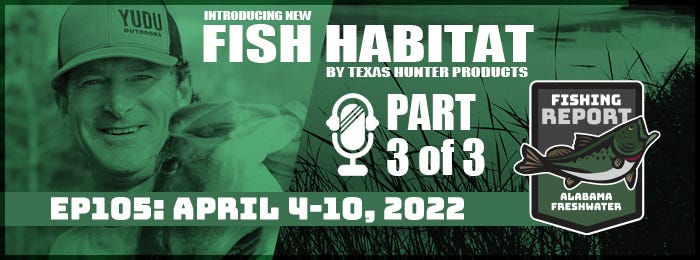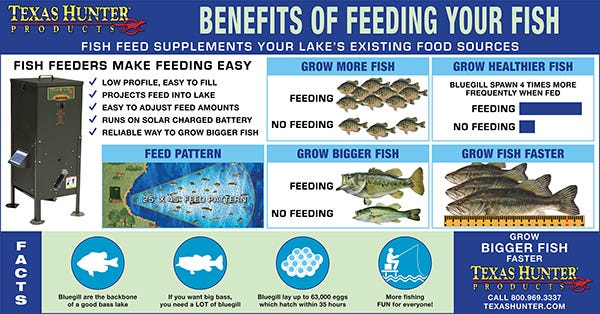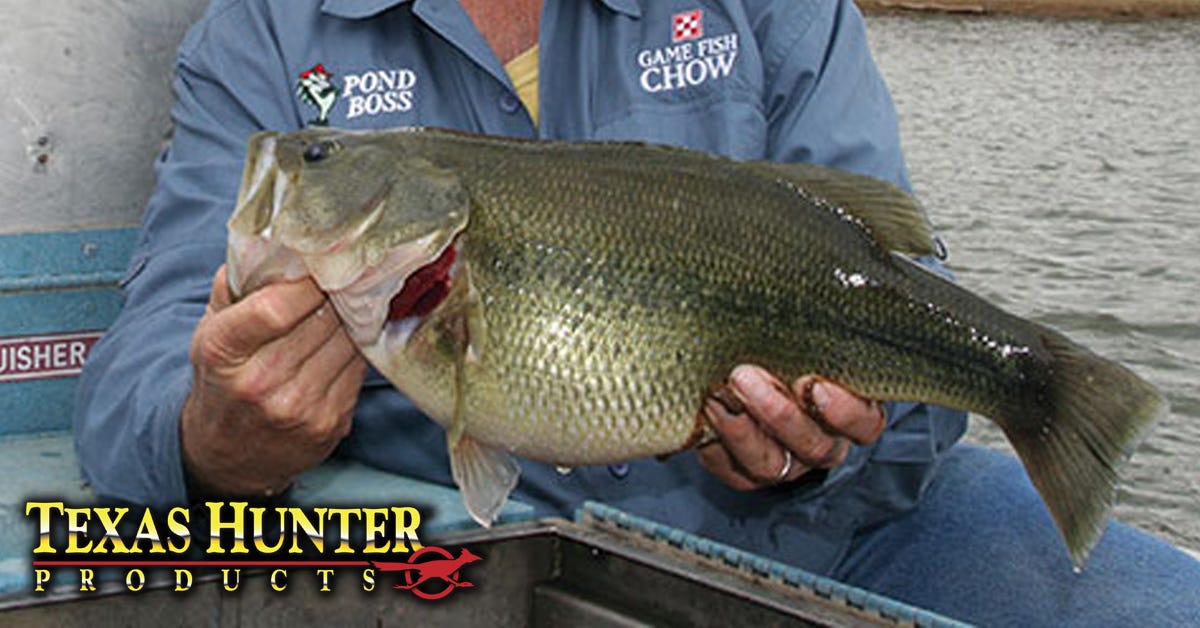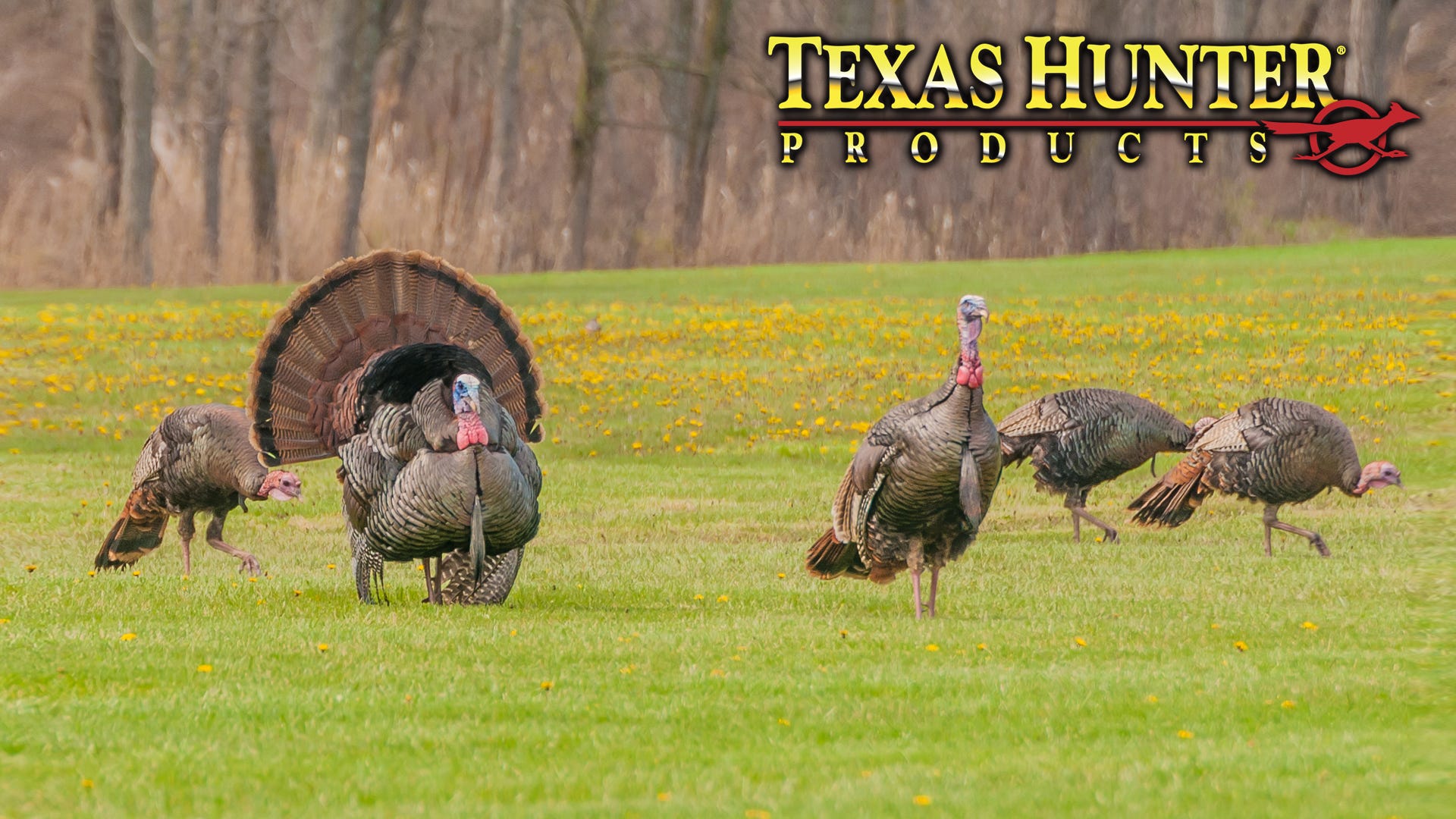- May 6, 2022
Alabama Freshwater Fishing Report Podcast - Part 3 of 3

Alabama Freshwater Fishing Report - April 4-10, 2022 - Fish Habitat Part 3 of 3
If you missed Part 1, read it here. If you missed Part 2, read it here.
Brian Senn: Well, Norman, I’m going to kind of go a different direction with this, because I know that there’s another love you have besides bass fishing and turkey hunting, which I know you love both of those. But you, you like to go out there offshore a little bit and saltwater and snapper fish, and all that. Is there plans in the future for you guys to develop some saltwater type attractants to hold fish?
Norman Latona: Yeah, you know I’ve mentioned this, but Chris, at one point a while back and I don’t know, he can address that. But certainly, that is become extremely popular in the Gulf of Mexico in areas of the Gulf where we fish, there’s literally thousands, or maybe tens of thousands, hundreds of thousands of private artificial reefs. And some of them are not all that big, you know.
It’s amazing. I’m blown away by you put something out there in that aquatic desert where there’s just nothing, nothing but sand, and it just immediately attracts fish. But you know, I don’t know whether Chris… and them have plans to do that, but it’s certainly effective offshore.
Chris Blood: Oh, I think absolutely, that’s something that we do want to look at. And we have some other designs that we’re exploring. And so, lots of opportunity, not just in the freshwater realm, but definitely saltwater and fish attractants in particular, and habitat in general. You bet.
Norman Latona: We used to take. And again, years back, it’s been a few years since I’ve done it, but, and I don’t want to incriminate myself. I’m not sure what the regulations are now about this. But the tripletails and black fish would come up into Mobile Bay, and usually in July and August, and just a whole bunch of fun to catch and they’re great to eat, and they really orient to shallow water cover.
And these things, we’d go out on a Bay, again, pretty much devoid of anything out there you know, for miles, square miles. And you can put a piece of plywood with insulation, get them to float and anchor them to the ground. And in no time at all, these tripletails would come up and orient to them.
And of course, they’re looking to attract baitfish, which is what attracted them. And so the shrimp trawlers didn’t really appreciate us doing that as much and they didn’t last long, because a trawl would rip them right out of the Bay. But yeah, fish orient to cover, there’s no question about that.
Brian Senn: No question. Yeah.
Norman Latona: They do it for a variety of reasons, and they all do it. They’re either looking to get away from being eaten, or to put themselves in a position to ambush something to eat, or to protect themselves from the elements, either the sunlight or to find a little bit of a thermal refuge in the heat of the summer.
So they do it for a wide range of reasons. They might utilize it for spawning. You know, one thing we didn’t even touch on is we stock a lot of threadfin shad into lakes, all over the southeast. And threadfin shads are a great source of food for bass.
And unlike bluegill and bass, threadfin shad, actually, and there are a lot of species that do this. They have, their eggs are sticky. They eject their eggs and they stick to some sort of substrate. And they’ll do it on sticks and brush tops and things, but they’ll also get up in the– on the edges, where there’s little bit of vegetation. Then they’ll spawn right in that vegetation and that grass, and their eggs will actually stick to it with that adhesive.
And so again, there’s lots of reasons that fish are looking for these sorts of items and they’re always going to seek them out and utilize them throughout the season, throughout the year.
Brian Senn: Very cool stuff, man. Well, obviously, one important question, Chris, for our listeners is if they want to find out more about this, they want to know where they can order it, take a look at the products. What’s the best way where do they need to go to look at the products, and how do they find a dealer in their area?
Chris Blood: Well, right now, they’re only available through a select group of dealers, like Southeastern Pond Management. We recommend that you reach out to your lake manager and Southeastern Pond Management in particular. And they can go and find out more about them, see the photos and learn more about the product at the website, TexasAnglerProducts.com That’s TexasAnglerProducts.com.
And there’s also a dealer locator there. They can click a button and put in their address or location, and we’ll get them in touch with the closest dealer. And Norman, let them know how to reach you because there’s very few dealers out there that have this product available. And Southeastern Pond is our premier partner in this, and they are the ones that we would recommend reaching out to and they can have it available, and even come out and install it, I’m sure.
Brian Senn: Yeah, absolutely. We’ll definitely get Norman’s contact on here as well for people to reach out to. But hey, congratulations, Chris! Y’all have created several incredible products that answers a lot of the questions and addresses a lot of the issues that we have in our ponds throughout the southeast and across the United States.
Man, I’m excited to see where this thing goes for you all. I know they’re going to be amazingly successful products for you. And, congratulations on it, brother!
Chris Blood: Well, thank you, Brian. Sure, appreciate you having me on today. And thank you, Norman, really enjoyed visiting with you guys today.
Brian Senn: Absolutely, man. Well, we’d love to have you back on soon and maybe get some updates. If you guys update your products and continue to develop new products. feel free to reach out to me or to Norman, and let’s get you back on again, brother.
Chris Blood: For sure. We appreciate that very much. Thank you, Brian.
Brian Senn: All right, guys, Norman, great stuff right there, man. I mean, this is so cool to see a company that’s known for, I mean, quality, quality products, right? Get into this world and the fishing side, and create, there again, quality products, lifetime products that will enhance your fishing.
Norman Latona: Absolutely. And there’s not a better group out there than the folks at Texas Hunter Products. They just stand behind what they do and a bunch of great folks who’ve been in the hunting and fishing industry for a long, long time, and we’re tickled that they’ve come out with this line of products. So, we’re really excited about them planning to put out quite a few of them over the coming months and years.
Brian Senn: Well, and you know, from a pond management standpoint, which is what you do every day, you know, you get calls, I’m sure all the time surrounding cover. And whether it’s getting rid of cover, that’s two prong, right? People either want to get rid of it, or they want to add it, And adding cover can get tricky. It can get very labor intensive, which is price, right? Because you’re charging. I mean, you all, the more labor intensive and more time stuff takes, the more charge, I’m sure there is for it. But, how are these products going to fit in to your everyday world?
Norman Latona: Yeah, when Chris and I started brainstorming about these products, the two things I said were most important to us from a pond management company perspective was ease of deployment and quality of material. In other words, I wanted something that that we could put out reasonably easily to keep the deployment cost, the labor cost down, and something that would last a lifetime.
Because I have spent and we have spent hundreds, thousands of hours over 30 some odd years, filling buckets, cementing Christmas trees into buckets and bamboo poles, and brush tops, and you name it. I mean, we put virtually anything and everything in lakes to add cover and habitat. And you know as well as I do, just like you were eluding to your crappie guide, you know, 12 or 18 months later, they’re gone, or at least for all intents purposes are gone.
So, what they did at Texas Hunter was take the very best materials they could find that they can ensure that would last a lifetime. And they built them in such a way that they’re light enough to ship around the country, to ship them to us, and make them relatively easy to deploy, to assemble and deploy.
Brian Senn: Not just for you guys, but for the fishermen, too, right?
Norman Latona: Absolutely. Absolutely.
Brian Senn: I know, like my dad, a crappie fisherman, I’ll send you some pictures and stuff that Tony has done. And he’s like, “My goodness, I don’t have any way to do that. I don’t have a way to transport that stuff,” or “I don’t have a boat. I got a little john boat. I don’t have a boat that I can put all that big stuff in and safely get it out there to where I want to create a bed or create habitat.”
Norman Latona: That’s right. Even if you have– even if you’re willing to spend 20 hours to do it, you’re right, do you even have the resources to do it?
Brian Senn: Right.
Norman Latona: So these were the things that we talked about, and I think they hit a homerun. You know, we spend day after day after month after month, figuring out ways to make these lakes productive, and you and I have talked about this numerous times before.
And everybody focuses on, how do we grow bigger fish, produce more fish, make them grow faster, keep them healthy, keep the lake in balance, on and on, and on. And all those are obviously cornerstone inputs, those are important. But what we sometimes forget is what we’re– while we’re growing these things, we’re growing them to catch them.<
Brian Senn: To catch them.
Norman Latona: And so this is a concept, this is an effort designed, aimed at increasing catchability and making the lake angler-friendly, and to where I can target fish in these areas. And I just promise you, they utilize these things. I’ve seen it firsthand, not that I ever had any doubt, because fish orient the structure and cover like we talked about for a wide range of reasons. But these things work and I think there’ll be folks will be really pleased if they give it a try.
Brian Senn: Well, good stuff, man. It’s awesome to see new products come out that help us with catching fish, whether it’s lures or whether it is structure, or whatever it is. I saw, you’re right, we can concentrate on the growing, concentrate on having everything else right, and the water quality, and all those things you mentioned. But at the end of the day, we want to catch fish and that’s what this is going to help you do.
So Norman, if somebody is interested in one of these products, they want to talk to you about your opinions on the products, or talk to you about coming to their lake to help put them out, or any other pond management question that they might have, what’s the best way for them to contact you?
Norman Latona: The best way to get me is just directly on my cell phone. That number is 205-288-1371, 205-288-1371. And they can always visit our website and run us down that way, and that’s sepond.com, S-E-P-O-N-D .com. Or call the office 888.830.POND.
Brian Senn: Good stuff, Norman. As always, brother, we appreciate it. We’ve enjoyed our time together and I look forward to talking to you again soon, my friend.
Norman Latona: Yup, same here, Brian. Take care.
Brian Senn: All right, guys, I told you all it was going to be a great show, and it was. I really appreciate Chris with Texas Hunter Products being on here. We all know their product from the hunting industry, know their quality, and it’s good to see them dive into the fishing world and create things that at the end of the day, make it easier for us to catch fish. It’s just got good stuff, man. It’s a lifetime stuff. You put it out, forget about it, and move on.
I always love having Norman on. His expertise is as good as anybody in the country. That’s for sure. He knows it and manages a lot of water around our state. And so if you ever have questions, please feel free. And look, man, you’ve heard me say it on here, you don’t have to call Norman just to hire him to do a job for you. If you’ve got a question about your pond, call Norman. He’ll answer the phone and he’ll talk to you about it, and offer all the advice that he can give. So don’t be bashful in reaching out to Norman. That’s all I’m saying.
Anyway, folks, that is going to wrap up the show for this week. If you’re enjoying the podcast, please take a minute to subscribe, rate, and review us wherever you listen to the podcast. And if you’d like us to email you the podcast, just text the word “fishing” to 314-665-1767 and we will email you the show each and every week. Stay safe on the water, guys. Look forward to talk with you all again soon.
##
If you missed Part 1, read it here. If you missed Part 2, read it here.
For information on purchasing Texas Angler Fish Habitat products, Texas Hunter Feeders and Lake Management Services in general, contact Southeastern Pond Management at www.SEPond.com or call 888.830.POND (7663).
For general information on Texas Hunter Products’ new Texas Angler Fish Habitat products and to watch the video or find a Lake Management dealer near you, visit www.TexasAnglerProducts.com.




